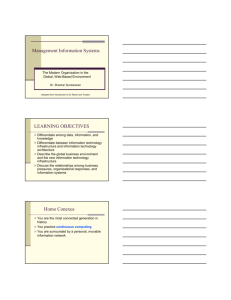Chapter 8
advertisement
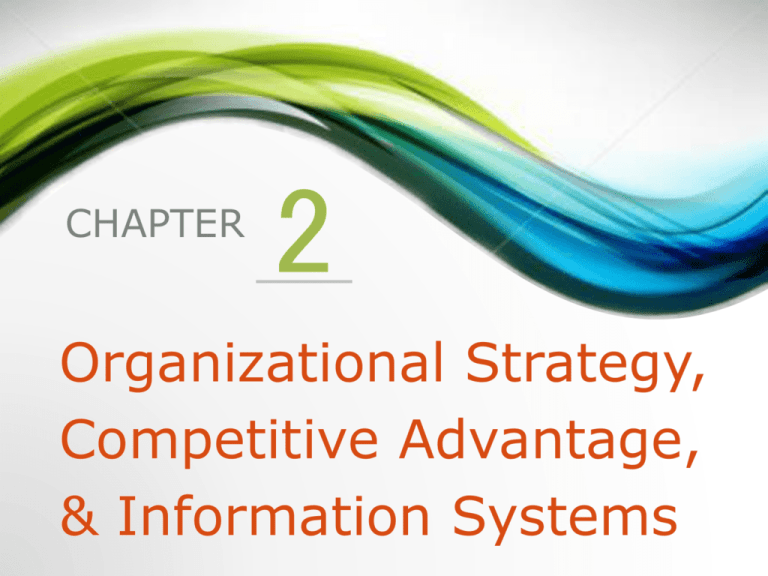
CHAPTER 2 Organizational Strategy, Competitive Advantage, & Information Systems 1. Business Pressures, Organizational Responses, and Information Technology Support 2. Competitive Advantage and Strategic Information Systems >>> 1. Identify effective IT responses to different kinds of business pressures. 2. Describe the strategies that organizations typically adopt to counter Porter’s five competitive forces. OPENING > • GrubHub Seamless 1. Look ahead in this chapter. Which one of Porter’s strategies for competitive advantage is GrubHub Seamless pursuing? Explain your answer. 2. Propose additional applications that GS could develop to gain a competitive advantage in the marketplace. 2.1 • • • • Business Pressures, Organizational Responses, and IT Support Competitive Advantage Business Environment Business Pressures Organizational Responses Business Pressures • Market Pressures • Technology Pressures • Societal/Political/Legal Pressures Figure 2.1: Business Pressures, Organizational Performance & Responses, and IT Support Market Pressures • Globalization • Changing Nature of the Workforce • Powerful Customers Globalization • Thomas Friedman – The World is Flat – Globalization 1.0 – Globalization 2.0 – Globalization 3.0 • Ten Flatteners Thomas Freidman: Ten Flatteners 1. Fall of the Berlin Wall on November 9, 1989 2. Netscape goes public on August 9, 1995 3. Development of workflow software 4. Uploading 5. Outsourcing 6. Offshoring 7. Supply chaining 8. Insourcing 9. Informing 10.The Steroids Technology Pressures • Technological Innovation and Obsolescence • Information Overload ’S ABOUT BUSINESS 2.1 • “Bring Your Own Device” Can Cause Problems 1. What are the advantages of allowing employees to use any mobile device to connect to the corporate network? The disadvantages? 2. Why is it necessary to be able to erase corporate data when a mobile device is lost or stolen? Societal/Political/Legal Pressures • Social Responsibility • Compliance with Government Regulations • Protection Against Terrorist Attacks • Ethical Issues Social Responsibility • IT Assists “Go Green” Efforts in Three Areas: 1. Facilities design and management 2. Carbon management 3. International and U.S. environmental laws • Digital Divide ’S ABOUT BUSINESS 2.2 • Solar-Powered Tablets in Ethiopia 1. What advantages could result from increasing the literacy of 100 million children around the world? Be specific. 2. In this experiment, the tablets were not connected to the Internet. Discuss the advantages and disadvantages to the children if the tablets were connected. Organizational Responses • Strategic Systems • Customer Focus • Make-to-Order and Mass Customization • E-Business and E-Commerce ’S ABOUT BUSINESS 2.3 • The Weather Channel 1. Identify several reasons (not discussed in the case) why accurate weather predictions are so important. Can an accurate weather prediction be considered a competitive advantage for an organization that receives this information? Why or why not? Support your answer with specific examples. 2. Will Dark Sky, Sky Motion, and WeatherSphere have a lasting competitive advantage over The Weather Channel? Why or why not? Support your answer. 2.2 Competitive Advantage and Strategic IS’s • Porter’s Competitive Forces Model • Porter’s Value Chain Model • Strategies for Competitive Advantage • Business – Information Technology Alignment Porter’s Five Forces Model 1. The threat of new competitors 2. The bargaining power of suppliers 3. The bargaining power of customers (buyers) 4. The threat of substitute products or services 5. The rivalry among existing firms in the industry Porter’s Value Chain Model • Value Chain • Two Categories of Organization Activities in the Value Chain – Primary Activities – Support Activities Figure 2.2: Porter’s Competitive Forces Model Primary Activities • • • • • Inbound logistics Operations Outbound logistics Marketing and sales Services Support Activities • The Firm’s Infrastructure • Human Resources Management • Product and Technology Development • Procurement Figure 2.3: Porter’s Value Chain Model Strategies for Competitive Advantage 1. Cost leadership strategy 2. Differentiation strategy 3. Innovation strategy 4. Organizational effectiveness strategy 5. Customer orientation strategy Business-Information Technology Alignment • Business–Information Technology Alignment • Six Characteristics of Excellent Business-IT Alignment: Figure 2.4: Strategies for Competitive Advantage Six Characteristics of Excellent Business-IT Alignment 1. Organizations view IT as an engine of innovation that continually transforms the business, often creating new revenue streams. 2. Organizations view their internal & external customers & their customer service function as supremely important. Six Characteristics of Excellent Business-IT Alignment (continued) 3. Organizations rotate business & IT professionals across departments and job functions. 4. Organizations provide overarching goals that are completely clear to each IT and business employee. Six Characteristics of Excellent Business-IT Alignment (continued) 5. Organizations ensure that IT employees understand how the company makes (or loses) money. 6. Organizations create a vibrant and inclusive company culture. ’S ABOUT BUSINESS 2.4 • The University of Pittsburgh Medical Center Makes Effective Use of IT 1. Describe the strategic advantages that IT provides to UPMC. 2. Which of Porter’s competitive strategies is UPMC employing? Support your answer. 3. Describe how UPMC illustrates effective business–IT alignment.
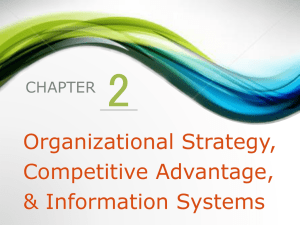


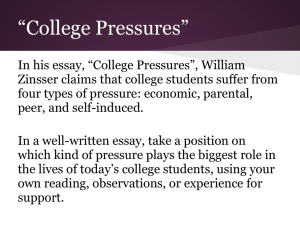
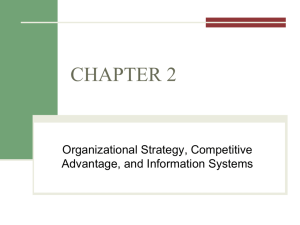
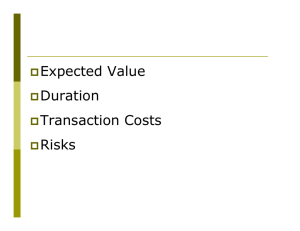

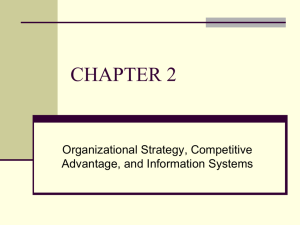
![[5] James William Porter The third member of the Kentucky trio was](http://s3.studylib.net/store/data/007720435_2-b7ae8b469a9e5e8e28988eb9f13b60e3-300x300.png)
